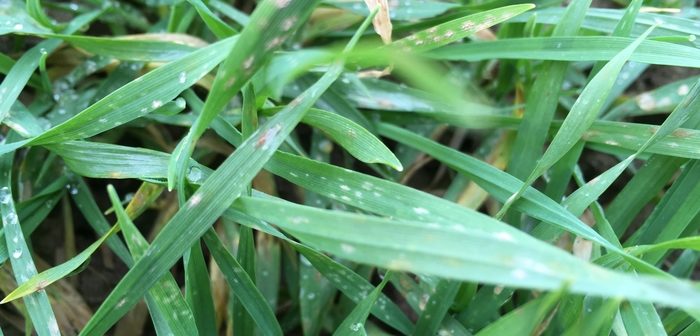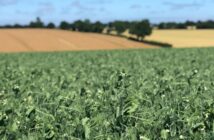Disease pressure in many crops of winter barley is very high this autumn, so growers should consider treating susceptible crops with an early fungicide to avoid compromising yield potential, advises leading agronomy firm Hutchinsons.
Mild, wet weather since September has favoured the development and spread of several diseases in early-sown crops across much of the UK, particularly net blotch, Rhynchosporium, powdery mildew and brown rust, the firm’s technical development director David Ellerton says.
Risk has been compounded by the large area of spring barley grown last season, which resulted in more barley volunteers emerging this autumn, from which infection can transfer to the new crop, he says.
“This combination of more inoculum on volunteers alongside mild, wet conditions, has been perfect for autumn barley diseases, although later drilled crops generally aren’t as badly affected.
“The situation is worst in varieties with low disease ratings of 4 or below (see box), and where there are a lot of volunteers from previous winter or spring barley crops. Manganese deficiency can also make crops more susceptible to mildew infection.”
Dr Ellerton says this increased disease risk may well be enough to justify an autumn or early spring fungicide application prior to stem extension, to prevent disease infections reducing the crop’s tillering capacity and yield potential.
Yield formation (tillers and subsequent grain number) in barley is determined much earlier in the season than for winter wheat, and several years of research shows that in high disease pressure autumns such as 2020, yield responses of over 0.5 t/ha are possible from an early fungicide, he says.
“It’s not something growers should do as routine, as on average you don’t get much of a yield response from an autumn fungicide.”
However, in previous seasons with high autumn disease levels, such as 2012 and 2015, the yield response to an autumn spray in trials averaged over 0.5 t/ha, he says. “In 2012 the autumn spray actually gave a bigger yield response than the T1 and T2, which just shows you really have to monitor crops closely and respond appropriately.”
Treatment options
Products containing prothioconazole will give the best control of net blotch, Rhynchosporium and mildew, while additional tebuconazole will be necessary for brown rust, Dr Ellerton advises.
“These products should generally be applied at half to three quarters dose depending on disease pressure.”
He acknowledges that wet ground conditions could make it impossible for growers to travel on fields to apply an autumn fungicide, but insists it is worth doing in high-risk crops if the opportunity arises.
“We’ve seen before that if disease is allowed to get established it will start to take out tillers and stress the crop, making it less able to cope with difficult weather later in the season.
“If you do get an opportunity to treat crops over coming weeks, it is a very effective way of setting disease back and could reduce the need for an early spray in the spring. That’s by no means certain though, especially if disease pressure remains high, when there can still be a big response from spring fungicides.”
With potential spray days at a premium during late autumn and winter, Dr Ellerton advises growers to be cautious about applying products in frosty conditions, or when using complex tank mixes including fungicides, insecticides and herbicides, and always follow label instructions.
“Multi-way mixes can be quite risky to apply, especially if they include active ingredients that are ‘hotter’ to crops.”
Key varieties at risk include:
- Net blotch: SY Venture, KWS Cresswell and KWS Tower (all rated 4)
- Rhynchosporium: KWS Glacier (4)
- Mildew: KWS Orwell (3), LG Flynn (4), KWS Glacier (4) and KWS Cassia (4)
- Brown rust: Belmont (4)




